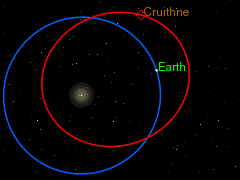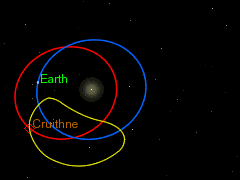<SNIP>What's this with Obama trying to reshoot Armageddon the movie?
Now the dip-shit wants us to fly to a friggen asteroid?
Is he smoking crack?
Oh yea, especially when we KNOW that NEA's have precious metals and minerals, along with other unknowns. Not to mention many of them are closer and more easily accesible than the moon and could be better spots than the moon to launch to Mars from.
<SNIP>
Everyone talks about their being water on the moon so we should set up a base, but the amount of water that bomb showed is akin to dropping a bomb in the sahara and looking for water molecules. We need to know if there's more outside of that rather large basin or if its actually deceptively dry before we just start setting up moon bases.
<SNIP>
I'm taking issue with your description of the amount of water found on the moon November of 2009 in the LCROSS experiment
Based on the measurements, the team estimated about 100 kilograms of water in the view of their instruments — the equivalent of about a dozen 2-gallon buckets — in the area of the impact crater (about 66 feet, or 20 meters across) and the ejecta blanket (about 60 to 80 meters across), Colaprete said.
"I'm pretty impressed by the amount of water we saw in our little 20-meter crater," Colaprete said.
How much is that?
There appears to be about 24 gallons in an area of about 2,400 square feet or a gallon per 10-feet x 10-feet area (or 100 square feet)
This water finding doesn't mean that the moon is wet by Earth's standards, but is likely wetter than some of the driest deserts on Earth, Colaprete said. And even this small amount is valuable to possible future missions, said Michael Wargo, chief lunar scientist for Exploration Systems at NASA
Scientists also are looking to see if there is any link between the water observed by LCROSS and that discovered by Chandrayaan-1.
What about Chandrayaan-1?
"Their observation is entirely unique and complementary to what we did," Colaprete said. Scientists still need to work out whether the water observed by Chandrayaan-1 might be slowly migrating to the poles, or if it is unrelated.
Bottom line, the discovery completely changes scientists' view of the moon, Wargo said.
*The discovery gives "a much bigger, potentially complicated picture for water on the moon" than what was thought even just a few months ago, he said. "This is not your father's moon; this is not a dead planetary body."
LINK TO ABOVE QUOTES
Missions to the moon are off the table for NASA.
That's what the president said and we have to take that as gospel until another administration changes it, which is unlikely to happen.
What may happen, though, is that "commercialization" of manned bases on the moon could be leveraged with challenge prizes. For those of us who see the moon as a stepping stone too good to waste, we can still hope.
Mining Near Earth Asteroids offers the advantage for our craft and crews to be able to work in "micro gravity" making for a great reduction in fuel use. But these near Earth asteroids are not anywhere close to Earth, they have orbits around the sun, and we can rendezvous and depart at different locations in their orbits but the time the crews spend in orbit will probably be greater than a year, and may be up to 18 months. Some asteroids have orbits resonant with Earth's.
Here's one of those asteroids, 3753 Cruithne
which fits the criteria of an NEA able to be mined.

Cruithne appears to make a bean-shaped orbit
from the perspective of Earth

Cruithne is approximately 5 kilometres (3.1 mi) in diameter, and its closest approach to Earth is approximately thirty times the separation between Earth and the Moon.
Through 2015, Cruithne will make its annual closest approach to Earth every November.
More on Cruithne
Edit: Inserted this quote above *
Last edited:


